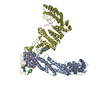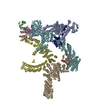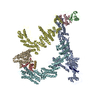[English] 日本語
 Yorodumi
Yorodumi- EMDB-36183: Cryo-EM structure of neddylated Cul2-Rbx1-EloBC-FEM1B complexed w... -
+ Open data
Open data
- Basic information
Basic information
| Entry |  | |||||||||
|---|---|---|---|---|---|---|---|---|---|---|
| Title | Cryo-EM structure of neddylated Cul2-Rbx1-EloBC-FEM1B complexed with FNIP1-FLCN | |||||||||
 Map data Map data | ||||||||||
 Sample Sample |
| |||||||||
 Keywords Keywords |  Complex / Complex /  E3 ubiquitin ligase / E3 ubiquitin ligase /  Cullin / Cullin /  LIGASE LIGASE | |||||||||
| Function / homology |  Function and homology information Function and homology informationregulation of ubiquitin-protein transferase activity / epithelial cell maturation involved in prostate gland development / positive regulation of B cell apoptotic process / negative regulation of lysosome organization / regulation of pro-B cell differentiation / branching involved in prostate gland morphogenesis / immature B cell differentiation / ATPase inhibitor activity / Amino acids regulate mTORC1 /  regulation of DNA damage checkpoint ...regulation of ubiquitin-protein transferase activity / epithelial cell maturation involved in prostate gland development / positive regulation of B cell apoptotic process / negative regulation of lysosome organization / regulation of pro-B cell differentiation / branching involved in prostate gland morphogenesis / immature B cell differentiation / ATPase inhibitor activity / Amino acids regulate mTORC1 / regulation of DNA damage checkpoint ...regulation of ubiquitin-protein transferase activity / epithelial cell maturation involved in prostate gland development / positive regulation of B cell apoptotic process / negative regulation of lysosome organization / regulation of pro-B cell differentiation / branching involved in prostate gland morphogenesis / immature B cell differentiation / ATPase inhibitor activity / Amino acids regulate mTORC1 /  regulation of DNA damage checkpoint / B cell apoptotic process / negative regulation of TOR signaling / ubiquitin-dependent protein catabolic process via the C-end degron rule pathway / target-directed miRNA degradation / elongin complex / VCB complex / regulation of DNA damage checkpoint / B cell apoptotic process / negative regulation of TOR signaling / ubiquitin-dependent protein catabolic process via the C-end degron rule pathway / target-directed miRNA degradation / elongin complex / VCB complex /  death receptor binding / regulation of extrinsic apoptotic signaling pathway via death domain receptors / Cul5-RING ubiquitin ligase complex / SCF-dependent proteasomal ubiquitin-dependent protein catabolic process / Cul2-RING ubiquitin ligase complex / death receptor binding / regulation of extrinsic apoptotic signaling pathway via death domain receptors / Cul5-RING ubiquitin ligase complex / SCF-dependent proteasomal ubiquitin-dependent protein catabolic process / Cul2-RING ubiquitin ligase complex /  SCF ubiquitin ligase complex / ubiquitin ligase complex scaffold activity / SCF ubiquitin ligase complex / ubiquitin ligase complex scaffold activity /  TOR signaling / Pausing and recovery of Tat-mediated HIV elongation / Tat-mediated HIV elongation arrest and recovery / HIV elongation arrest and recovery / Pausing and recovery of HIV elongation / ubiquitin-like ligase-substrate adaptor activity / TOR signaling / Pausing and recovery of Tat-mediated HIV elongation / Tat-mediated HIV elongation arrest and recovery / HIV elongation arrest and recovery / Pausing and recovery of HIV elongation / ubiquitin-like ligase-substrate adaptor activity /  enzyme activator activity / positive regulation of TOR signaling / Tat-mediated elongation of the HIV-1 transcript / Formation of HIV-1 elongation complex containing HIV-1 Tat / Formation of HIV elongation complex in the absence of HIV Tat / RNA Polymerase II Transcription Elongation / Formation of RNA Pol II elongation complex / positive regulation of TORC1 signaling / RNA Polymerase II Pre-transcription Events / cellular response to starvation / intrinsic apoptotic signaling pathway / B cell differentiation / transcription corepressor binding / transcription elongation by RNA polymerase II / enzyme activator activity / positive regulation of TOR signaling / Tat-mediated elongation of the HIV-1 transcript / Formation of HIV-1 elongation complex containing HIV-1 Tat / Formation of HIV elongation complex in the absence of HIV Tat / RNA Polymerase II Transcription Elongation / Formation of RNA Pol II elongation complex / positive regulation of TORC1 signaling / RNA Polymerase II Pre-transcription Events / cellular response to starvation / intrinsic apoptotic signaling pathway / B cell differentiation / transcription corepressor binding / transcription elongation by RNA polymerase II /  transcription initiation at RNA polymerase II promoter / positive regulation of protein-containing complex assembly / TP53 Regulates Transcription of DNA Repair Genes / transcription initiation at RNA polymerase II promoter / positive regulation of protein-containing complex assembly / TP53 Regulates Transcription of DNA Repair Genes /  regulation of protein phosphorylation / Vif-mediated degradation of APOBEC3G / G1/S transition of mitotic cell cycle / negative regulation of cysteine-type endopeptidase activity involved in apoptotic process / Oxygen-dependent proline hydroxylation of Hypoxia-inducible Factor Alpha / Inactivation of CSF3 (G-CSF) signaling / Regulation of expression of SLITs and ROBOs / ubiquitin-protein transferase activity / protein-macromolecule adaptor activity / positive regulation of proteasomal ubiquitin-dependent protein catabolic process / Antigen processing: Ubiquitination & Proteasome degradation / positive regulation of peptidyl-serine phosphorylation / regulation of protein phosphorylation / Vif-mediated degradation of APOBEC3G / G1/S transition of mitotic cell cycle / negative regulation of cysteine-type endopeptidase activity involved in apoptotic process / Oxygen-dependent proline hydroxylation of Hypoxia-inducible Factor Alpha / Inactivation of CSF3 (G-CSF) signaling / Regulation of expression of SLITs and ROBOs / ubiquitin-protein transferase activity / protein-macromolecule adaptor activity / positive regulation of proteasomal ubiquitin-dependent protein catabolic process / Antigen processing: Ubiquitination & Proteasome degradation / positive regulation of peptidyl-serine phosphorylation /  Neddylation / ubiquitin-dependent protein catabolic process / protein-folding chaperone binding / proteasome-mediated ubiquitin-dependent protein catabolic process / protein-containing complex assembly / protein ubiquitination / positive regulation of protein phosphorylation / lysosomal membrane / negative regulation of cell population proliferation / apoptotic process / Neddylation / ubiquitin-dependent protein catabolic process / protein-folding chaperone binding / proteasome-mediated ubiquitin-dependent protein catabolic process / protein-containing complex assembly / protein ubiquitination / positive regulation of protein phosphorylation / lysosomal membrane / negative regulation of cell population proliferation / apoptotic process /  ubiquitin protein ligase binding / protein-containing complex binding / ubiquitin protein ligase binding / protein-containing complex binding /  nucleolus / regulation of transcription by RNA polymerase II / negative regulation of transcription by RNA polymerase II / nucleolus / regulation of transcription by RNA polymerase II / negative regulation of transcription by RNA polymerase II /  enzyme binding / enzyme binding /  nucleoplasm / nucleoplasm /  metal ion binding / metal ion binding /  nucleus / nucleus /  cytosol / cytosol /  cytoplasm cytoplasmSimilarity search - Function | |||||||||
| Biological species |   Homo sapiens (human) Homo sapiens (human) | |||||||||
| Method |  single particle reconstruction / single particle reconstruction /  cryo EM / Resolution: 3.63 Å cryo EM / Resolution: 3.63 Å | |||||||||
 Authors Authors | Dai Z / Liang L / Yin YX | |||||||||
| Funding support |  China, 1 items China, 1 items
| |||||||||
 Citation Citation |  Journal: EMBO J / Year: 2024 Journal: EMBO J / Year: 2024Title: Structural insights into the ubiquitylation strategy of the oligomeric CRL2 E3 ubiquitin ligase. Authors: Zonglin Dai / Ling Liang / Weize Wang / Peng Zuo / Shang Yu / Yaqi Liu / Xuyang Zhao / Yishuo Lu / Yan Jin / Fangting Zhang / Dian Ding / Weiwei Deng / Yuxin Yin /   Abstract: Cullin-RING E3 ubiquitin ligase (CRL) family members play critical roles in numerous biological processes and diseases including cancer and Alzheimer's disease. Oligomerization of CRLs has been ...Cullin-RING E3 ubiquitin ligase (CRL) family members play critical roles in numerous biological processes and diseases including cancer and Alzheimer's disease. Oligomerization of CRLs has been reported to be crucial for the regulation of their activities. However, the structural basis for its regulation and mechanism of its oligomerization are not fully known. Here, we present cryo-EM structures of oligomeric CRL2 in its unneddylated state, neddylated state in complex with BEX2 as well as neddylated state in complex with FNIP1/FLCN. These structures reveal that asymmetric dimerization of N8-CRL2 is critical for the ubiquitylation of BEX2 while FNIP1/FLCN is ubiquitylated by monomeric CRL2. Our data present an example of the asymmetric homo-dimerization of CRL. Taken together, this study sheds light on the ubiquitylation strategy of oligomeric CRL2 according to substrates with different scales. | |||||||||
| History |
|
- Structure visualization
Structure visualization
| Supplemental images |
|---|
- Downloads & links
Downloads & links
-EMDB archive
| Map data |  emd_36183.map.gz emd_36183.map.gz | 253.1 MB |  EMDB map data format EMDB map data format | |
|---|---|---|---|---|
| Header (meta data) |  emd-36183-v30.xml emd-36183-v30.xml emd-36183.xml emd-36183.xml | 20.4 KB 20.4 KB | Display Display |  EMDB header EMDB header |
| FSC (resolution estimation) |  emd_36183_fsc.xml emd_36183_fsc.xml | 17.1 KB | Display |  FSC data file FSC data file |
| Images |  emd_36183.png emd_36183.png | 65.1 KB | ||
| Filedesc metadata |  emd-36183.cif.gz emd-36183.cif.gz | 7.2 KB | ||
| Others |  emd_36183_half_map_1.map.gz emd_36183_half_map_1.map.gz emd_36183_half_map_2.map.gz emd_36183_half_map_2.map.gz | 474.4 MB 474.4 MB | ||
| Archive directory |  http://ftp.pdbj.org/pub/emdb/structures/EMD-36183 http://ftp.pdbj.org/pub/emdb/structures/EMD-36183 ftp://ftp.pdbj.org/pub/emdb/structures/EMD-36183 ftp://ftp.pdbj.org/pub/emdb/structures/EMD-36183 | HTTPS FTP |
-Related structure data
| Related structure data |  8je2MC  8ij1C  8je1C M: atomic model generated by this map C: citing same article ( |
|---|---|
| Similar structure data | Similarity search - Function & homology  F&H Search F&H Search |
- Links
Links
| EMDB pages |  EMDB (EBI/PDBe) / EMDB (EBI/PDBe) /  EMDataResource EMDataResource |
|---|---|
| Related items in Molecule of the Month |
- Map
Map
| File |  Download / File: emd_36183.map.gz / Format: CCP4 / Size: 512 MB / Type: IMAGE STORED AS FLOATING POINT NUMBER (4 BYTES) Download / File: emd_36183.map.gz / Format: CCP4 / Size: 512 MB / Type: IMAGE STORED AS FLOATING POINT NUMBER (4 BYTES) | ||||||||||||||||||||
|---|---|---|---|---|---|---|---|---|---|---|---|---|---|---|---|---|---|---|---|---|---|
| Voxel size | X=Y=Z: 0.83 Å | ||||||||||||||||||||
| Density |
| ||||||||||||||||||||
| Symmetry | Space group: 1 | ||||||||||||||||||||
| Details | EMDB XML:
|
-Supplemental data
-Half map: #1
| File | emd_36183_half_map_1.map | ||||||||||||
|---|---|---|---|---|---|---|---|---|---|---|---|---|---|
| Projections & Slices |
| ||||||||||||
| Density Histograms |
-Half map: #2
| File | emd_36183_half_map_2.map | ||||||||||||
|---|---|---|---|---|---|---|---|---|---|---|---|---|---|
| Projections & Slices |
| ||||||||||||
| Density Histograms |
- Sample components
Sample components
-Entire : Neddylated Cul2-Rbx1-EloBC-FEM1B complexed with FNIP1-FLCN
| Entire | Name: Neddylated Cul2-Rbx1-EloBC-FEM1B complexed with FNIP1-FLCN |
|---|---|
| Components |
|
-Supramolecule #1: Neddylated Cul2-Rbx1-EloBC-FEM1B complexed with FNIP1-FLCN
| Supramolecule | Name: Neddylated Cul2-Rbx1-EloBC-FEM1B complexed with FNIP1-FLCN type: complex / ID: 1 / Parent: 0 / Macromolecule list: #1-#5 |
|---|---|
| Source (natural) | Organism:   Homo sapiens (human) Homo sapiens (human) |
-Macromolecule #1: Cullin-2
| Macromolecule | Name: Cullin-2 / type: protein_or_peptide / ID: 1 / Number of copies: 1 / Enantiomer: LEVO |
|---|---|
| Source (natural) | Organism:   Homo sapiens (human) Homo sapiens (human) |
| Molecular weight | Theoretical: 87.92782 KDa |
| Recombinant expression | Organism:   Spodoptera frugiperda (fall armyworm) Spodoptera frugiperda (fall armyworm) |
| Sequence | String: MSLKPRVVDF DETWNKLLTT IKAVVMLEYV ERATWNDRFS DIYALCVAYP EPLGERLYTE TKIFLENHVR HLHKRVLESE EQVLVMYHR YWEEYSKGAD YMDCLYRYLN TQFIKKNKLT EADLQYGYGG VDMNEPLMEI GELALDMWRK LMVEPLQAIL I RMLLREIK ...String: MSLKPRVVDF DETWNKLLTT IKAVVMLEYV ERATWNDRFS DIYALCVAYP EPLGERLYTE TKIFLENHVR HLHKRVLESE EQVLVMYHR YWEEYSKGAD YMDCLYRYLN TQFIKKNKLT EADLQYGYGG VDMNEPLMEI GELALDMWRK LMVEPLQAIL I RMLLREIK NDRGGEDPNQ KVIHGVINSF VHVEQYKKKF PLKFYQEIFE SPFLTETGEY YKQEASNLLQ ESNCSQYMEK VL GRLKDEE IRCRKYLHPS SYTKVIHECQ QRMVADHLQF LHAECHNIIR QEKKNDMANM YVLLRAVSTG LPHMIQELQN HIH DEGLRA TSNLTQENMP TLFVESVLEV HGKFVQLINT VLNGDQHFMS ALDKALTSVV NYREPKSVCK APELLAKYCD NLLK KSAKG MTENEVEDRL TSFITVFKYI DDKDVFQKFY ARMLAKRLIH GLSMSMDSEE AMINKLKQAC GYEFTSKLHR MYTDM SVSA DLNNKFNNFI KNQDTVIDLG ISFQIYVLQA GAWPLTQAPS STFAIPQELE KSVQMFELFY SQHFSGRKLT WLHYLC TGE VKMNYLGKPY VAMVTTYQMA VLLAFNNSET VSYKELQDST QMNEKELTKT IKSLLDVKMI NHDSEKEDID AESSFSL NM NFSSKRTKFK ITTSMQKDTP QEMEQTRSAV DEDRKMYLQA AIVRIMKARK VLRHNALIQE VISQSRARFN PSISMIKK C IEVLIDKQYI ERSQASADEY SYVAHHHHHH UniProtKB:  Cullin-2 Cullin-2 |
-Macromolecule #2: Elongin-B
| Macromolecule | Name: Elongin-B / type: protein_or_peptide / ID: 2 / Number of copies: 1 / Enantiomer: LEVO |
|---|---|
| Source (natural) | Organism:   Homo sapiens (human) Homo sapiens (human) |
| Molecular weight | Theoretical: 11.748406 KDa |
| Recombinant expression | Organism:   Escherichia coli (E. coli) Escherichia coli (E. coli) |
| Sequence | String: MDVFLMIRRH KTTIFTDAKE SSTVFELKRI VEGILKRPPD EQRLYKDDQL LDDGKTLGEC GFTSQTARPQ APATVGLAFR ADDTFEALC IEPFSSPPEL PDVMK UniProtKB: Elongin-B |
-Macromolecule #3: Elongin-C
| Macromolecule | Name: Elongin-C / type: protein_or_peptide / ID: 3 / Number of copies: 1 / Enantiomer: LEVO |
|---|---|
| Source (natural) | Organism:   Homo sapiens (human) Homo sapiens (human) |
| Molecular weight | Theoretical: 11.045694 KDa |
| Recombinant expression | Organism:   Escherichia coli (E. coli) Escherichia coli (E. coli) |
| Sequence | String: MAMYVKLISS DGHEFIVKRE HALTSGTIKA MLSGPGQFAE NETNEVNFRE IPSHVLSKVC MYFTYKVRYT NSSTEIPEFP IAPEIALEL LMAANFLDC UniProtKB: Elongin-C |
-Macromolecule #4: Protein fem-1 homolog B
| Macromolecule | Name: Protein fem-1 homolog B / type: protein_or_peptide / ID: 4 / Number of copies: 1 / Enantiomer: LEVO |
|---|---|
| Source (natural) | Organism:   Homo sapiens (human) Homo sapiens (human) |
| Molecular weight | Theoretical: 70.688406 KDa |
| Recombinant expression | Organism:   Escherichia coli (E. coli) Escherichia coli (E. coli) |
| Sequence | String: GEFMEGLAGY VYKAASEGKV LTLAALLLNR SESDIRYLLG YVSQQGGQRS TPLIIAARNG HAKVVRLLLE HYRVQTQQTG TVRFDGYVI DGATALWCAA GAGHFEVVKL LVSHGANVNH TTVTNSTPLR AACFDGRLDI VKYLVENNAN ISIANKYDNT C LMIAAYKG ...String: GEFMEGLAGY VYKAASEGKV LTLAALLLNR SESDIRYLLG YVSQQGGQRS TPLIIAARNG HAKVVRLLLE HYRVQTQQTG TVRFDGYVI DGATALWCAA GAGHFEVVKL LVSHGANVNH TTVTNSTPLR AACFDGRLDI VKYLVENNAN ISIANKYDNT C LMIAAYKG HTDVVRYLLE QRADPNAKAH CGATALHFAA EAGHIDIVKE LIKWRAAIVV NGHGMTPLKV AAESCKADVV EL LLSHADC DRRSRIEALE LLGASFANDR ENYDIIKTYH YLYLAMLERF QDGDNILEKE VLPPIHAYGN RTECRNPQEL ESI RQDRDA LHMEGLIVRE RILGADNIDV SHPIIYRGAV YADNMEFEQC IKLWLHALHL RQKGNRNTHK DLLRFAQVFS QMIH LNETV KAPDIECVLR CSVLEIEQSM NRVKNISDAD VHNAMDNYEC NLYTFLYLVC ISTKTQCSEE DQCKINKQIY NLIHL DPRT REGFTLLHLA VNSNTPVDDF HTNDVCSFPN ALVTKLLLDC GAEVNAVDNE GNSALHIIVQ YNRPISDFLT LHSIII SLV EAGAHTDMTN KQNKTPLDKS TTGVSEILLK TQMKMSLKCL AARAVRANDI NYQDQIPRTL EEFVGFH UniProtKB: Protein fem-1 homolog B |
-Macromolecule #5: Folliculin-interacting protein 1
| Macromolecule | Name: Folliculin-interacting protein 1 / type: protein_or_peptide / ID: 5 / Number of copies: 1 / Enantiomer: LEVO |
|---|---|
| Source (natural) | Organism:   Homo sapiens (human) Homo sapiens (human) |
| Molecular weight | Theoretical: 131.499906 KDa |
| Recombinant expression | Organism:   Homo sapiens (human) Homo sapiens (human) |
| Sequence | String: MAPTLFQKLF SKRTGLGAPG RDARDPDCGF SWPLPEFDPS QIRLIVYQDC ERRGRNVLFD SSVKRRNEDI SVSKLGSDAQ VKVFGKCCQ LKPGGDSSSS LDSSVTSSSD IKDQCLKYQG SRCSSDANML GEMMFGSVAM SYKGSTLKIH QIRSPPQLML S KVFTARTG ...String: MAPTLFQKLF SKRTGLGAPG RDARDPDCGF SWPLPEFDPS QIRLIVYQDC ERRGRNVLFD SSVKRRNEDI SVSKLGSDAQ VKVFGKCCQ LKPGGDSSSS LDSSVTSSSD IKDQCLKYQG SRCSSDANML GEMMFGSVAM SYKGSTLKIH QIRSPPQLML S KVFTARTG SSICGSLNTL QDSLEFINQD NNTLKADNNT VINGLLGNIG LSQFCSPRRA FSEQGPLRLI RSASFFAVHS NP MDMPGRE LNEDRDSGIA RSASLSSLLI TPFPSPNSSL TRSCASSYQR RWRRSQTTSL ENGVFPRWSI EESFNLSDES CGP NPGIVR KKKIAIGVIF SLSKDEDENN KFNEFFFSHF PLFESHMNKL KSAIEQAMKM SRRSADASQR SLAYNRIVDA LNEF RTTIC NLYTMPRIGE PVWLTMMSGT PEKNHLCYRF MKEFTFLMEN ASKNQFLPAL ITAVLTNHLA WVPTVMPNGQ PPIKI FLEK HSSQSVDMLA KTHPYNPLWA QLGDLYGAIG SPVRLARTVV VGKRQDMVQR LLYFLTYFIR CSELQETHLL ENGEDE AIV MPGTVITTTL EKGEIEESEY VLVTMHRNKS SLLFKESEEI RTPNCNCKYC SHPLLGQNVE NISQQEREDI QNSSKEL LG ISDECQMISP SDCQEENAVD VKQYRDKLRT CFDAKLETVV CTGSVPVDKC ALSESGLEST EETWQSEKLL DSDSHTGK A MRSTGMVVEK KPPDKIVPAS FSCEAAQTKV TFLIGDSMSP DSDTELRSQA VVDQITRHHT KPLKEERGAI DQHQETKQT TKDQSGESDT QNMVSEEPCE LPCWNHSDPE SMSLFDEYFN DDSIETRTID DVPFKTSTDS KDHCCMLEFS KILCTKNNKQ NNEFCKCIE TVPQDSCKTC FPQQDQRDTL SILVPHGDKE SSDKKIAVGT EWDIPRNESS DSALGDSESE DTGHDMTRQV S SYYGGEQE DWAEEDEIPF PGSKLIEVSA VQPNIANFGR SLLGGYCSSY VPDFVLQGIG SDERFRQCLM SDLSHAVQHP VL DEPIAEA VCIIADMDKW TVQVASSQRR VTDNKLGKEV LVSSLVSNLL HSTLQLYKHN LSPNFCVMHL EDRLQELYFK SKM LSEYLR GQMRVHVKEL GVVLGIESSD LPLLAAVAST HSPYVAQILL ENLYFQ UniProtKB: Folliculin-interacting protein 1 |
-Macromolecule #6: ZINC ION
| Macromolecule | Name: ZINC ION / type: ligand / ID: 6 / Number of copies: 1 / Formula: ZN |
|---|---|
| Molecular weight | Theoretical: 65.409 Da |
-Experimental details
-Structure determination
| Method |  cryo EM cryo EM |
|---|---|
 Processing Processing |  single particle reconstruction single particle reconstruction |
| Aggregation state | particle |
- Sample preparation
Sample preparation
| Concentration | 1.93 mg/mL |
|---|---|
| Buffer | pH: 7.5 |
| Vitrification | Cryogen name: ETHANE |
- Electron microscopy
Electron microscopy
| Microscope | FEI TITAN KRIOS |
|---|---|
| Electron beam | Acceleration voltage: 300 kV / Electron source:  FIELD EMISSION GUN FIELD EMISSION GUN |
| Electron optics | Illumination mode: FLOOD BEAM / Imaging mode: BRIGHT FIELD Bright-field microscopy / Nominal defocus max: 2.0 µm / Nominal defocus min: 1.5 µm Bright-field microscopy / Nominal defocus max: 2.0 µm / Nominal defocus min: 1.5 µm |
| Image recording | Film or detector model: GATAN K3 BIOQUANTUM (6k x 4k) / Average electron dose: 50.0 e/Å2 |
| Experimental equipment |  Model: Titan Krios / Image courtesy: FEI Company |
 Movie
Movie Controller
Controller


















 Z
Z Y
Y X
X


















